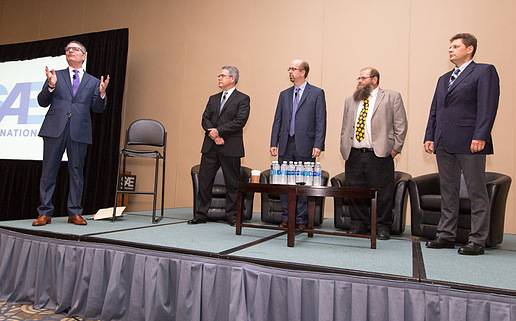 伊顿汽车集团的Mihai Dorobantu(左一)担任本场嘉宾讨论主持人,其他嘉宾包括:卡车制造商协会的Timothy Blubagh、北美货运效率委员会的David Schaller、西维吉尼亚大学的Nigel Clark,以及AVL集团公司的Lukas Walter(从左到右)。
伊顿汽车集团的Mihai Dorobantu(左一)担任本场嘉宾讨论主持人,其他嘉宾包括:卡车制造商协会的Timothy Blubagh、北美货运效率委员会的David Schaller、西维吉尼亚大学的Nigel Clark,以及AVL集团公司的Lukas Walter(从左到右)。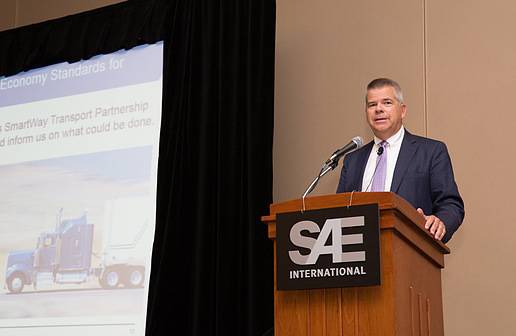 美国环保署交通运输与空气质量办公室主任Christopher Grundler表示,在应对气候变化方面,“我们真的是在与时间赛跑。”。
美国环保署交通运输与空气质量办公室主任Christopher Grundler表示,在应对气候变化方面,“我们真的是在与时间赛跑。”。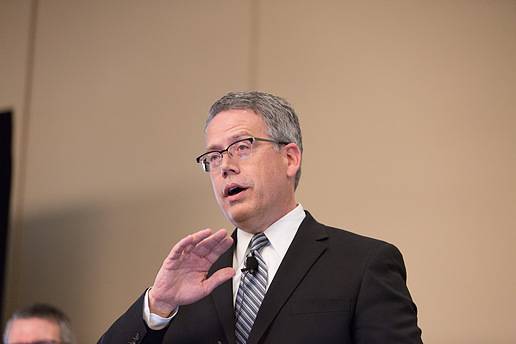 全美卡车制造商协会(Truck Manufacturers Association)Timothy Blubaugh
全美卡车制造商协会(Truck Manufacturers Association)Timothy Blubaugh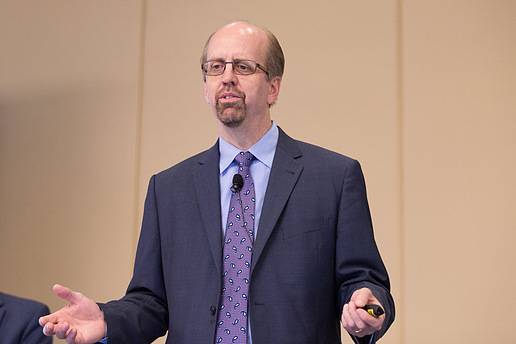 NACFE的David Shcaller指出,SAE等支持性组织应尽快起草必要标准与措施,支持行业工作的推进。
NACFE的David Shcaller指出,SAE等支持性组织应尽快起草必要标准与措施,支持行业工作的推进。 西维吉尼亚大学的Nigel Clark表示,“建立道路统计数据库,将有助于推动设计和认证方面的发展。”
西维吉尼亚大学的Nigel Clark表示,“建立道路统计数据库,将有助于推动设计和认证方面的发展。”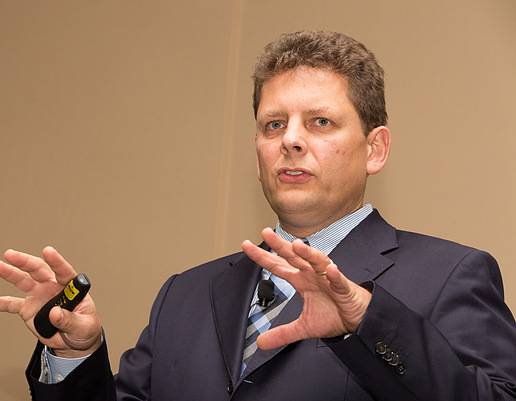 AVL集团公司的LukasWalter表示,“二氧化碳的减排要求将推动替代能源的未来发展。”
AVL集团公司的LukasWalter表示,“二氧化碳的减排要求将推动替代能源的未来发展。”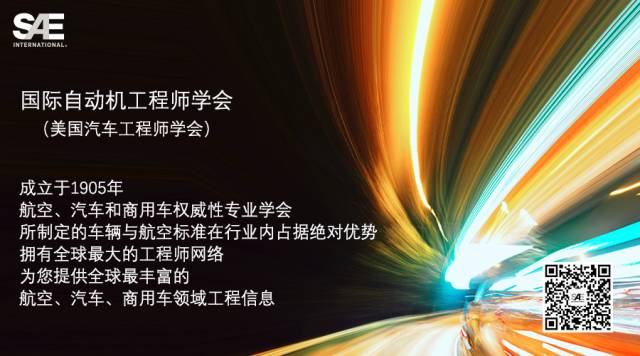
在2016年SAE International商用车辆工程大会首日举办的“应对(中、重型商用车的)第二阶段温室气体排放挑战:影响与效果”研讨会上,广大专家、学者及从业人员相聚一堂,共同探讨如何应对相关挑战。当日,美国环保署交通运输与空气质量办公室主任ChristopherGrundler发表主题演讲,为大会拉开帷幕。在演讲中,Grundler强调了实施排放法规对控制排放的重要作用,比如最近发布的第二阶段温室气体排放标准(影响范围为2021-2027型号年的中/重载公路车型)。
“我们必须加快推进我们的计划,现在真的是在与时间赛跑。”他在提到全球气候变化时表示,“我们正在进入一个未知的领域,”目前大气中的CO2水平首次超过400ppm。
根据美国环保署和国家公路交通安全管理局(NHTSA)的预计,整个项目可以减排超过10亿吨CO2、节约20亿桶原油,并同时为车主节约1700亿美元的燃料费用。
对于本身就在监管范围内的7级和8级联合拖拉机而言,与第一阶段标准相比,完全生效后的第二阶段标准最高可降低25%的CO2排放和燃料消耗;对于第二阶段刚刚纳入监管范围的重载联合拖拉机拖车而言,新标准在完全生效后预计可以使2017款拖车最高减排9%。
环保署与安全局称第二阶段为“技术进步”阶段,需要目前尚未广泛应用的新兴技术积极投入使用,发挥作用。不过,Grundler很快指出,新标准为“技术中立”,并不倾向于某项具体技术。
“我们的工作不仅仅是制定标准,然后拿出一些数字,”Grundler说,“如果使用这些卡车的用户不愿大量购买新技术,那我们就失败了。”
主题演讲后,4位行业专家也就这一主题发表了各自的观点。来自全美卡车制造商协会(Truck Manufacturers Association)的Timothy Blubaugh再次重申了其他几位发言人在大会上的发言,表示必须建立一套全国性的标准,方便厂商制造可直接面向全美各州的标准车型和发动机。
“为了保证全美50个州的同步参与,加州必须采用第二阶段标准。”Blubaugh表示,“我们听到一些声音说,CARB认为某些不在美国监管范围之内的特种车辆可以享有一些灵活度。因此,我们有点担心,因为我们必须保证一致性,这至关重要。”
北美货运效率委员会(North American Council for Freight Efficiency,NACFE)Dave Schaller一直在协助车队了解各种技术,包括一些可以提高能效的技术,以及那些可能在特定应用情况下并不非常有效的应用。
Schaller表示,“怎样才能让车队对这些技术有信心,愿意为其付费,这是一个问题,因为他们有很多选择的机会。”他指出,NACFE的网站上已经测评了大约70种适用于8级长途和区域货车的新技术。
现在看来,技术实施的五大障碍分别为回报时间不确定、可靠性存疑、资金来源缺乏、可靠信息不足以及可用技术缺乏。
Schaller与其在NACFE的同事Michael Roeth在SAE所发表的技术论文(2016-01-8014)中描述了车队面临的困难,“对于车队而言,这些技术可能很难为他们带来真正收益。轻量化技术可以方便一些对关注重量的车队运营,但对于其他所有车队而言,这种技术很难真正提高车队的回报。”这只是他们在论文中的一个例子。
Schaller和Roeth还指出,SAE和技术与维护委员会(Technology & Maintenance Council)等支持性组织应尽快起草必要标准与措施,支持行业尽快开发采用节油技术。
西维吉尼亚大学的Nigel Clark表示,随着我们收集的数据越来越多,以及对负载和天气等参数的理解越来越深刻,未来我们的道路统计数据库也将越来越庞大,并发挥更大作用,这可以帮助我们了解真实世界的情况。目前,Clark正在西弗吉尼亚大学的替代燃料、发动机与排放研究中心(WVU Center for Alternative Fuels, Engines and Emissions)开展相关研究。
“道路统计数据库将有助于推动设计和认证方面的发展,”他说,“我们必须在更多了解同一类车辆在不同行业和负载之下的情况。现在,大量的信息均留在车队内部了。”
Clark着重介绍了一系列有助于提高燃油效率的“工具箱中的工具”,并指出另外一些可能带来挑战的技术,比如余热回收系统。
“如果你选择利用废热,这项技术可能会花你很多钱,”他说,“利用余热的方式有很多种,但经济性并不高,而且这还会增加车辆的重量。因此,我们在使用余热时必须提前进行很多测评,这只是一个例子。”
AVL公司的Lukas Walter认为,只要进行进一步的开发和优化,行业“绝对可以”凭借现有技术实现即将生效的第二阶段标准。他认为,商用车领域应当寻找与其他行业共用零部件的机会,从而优化电池等技术的商业效益。
有没有一种技术可以将CO2排放降低20%以上?Walter在会上提出这个问题,并称替代能源可能是一种答案。举例来说,AVL的测试结果显示,与柴油发动机相比,在同等扭矩水平下,天然气直喷系统的排放量要低20%以上。
Walter表示,“二氧化碳的减排要求将推动替代能源的未来发展。”
Opening day of the SAE 2016 Commercial Vehicle Engineering Congress featured a well-attended symposium on Meeting the Challenges of Phase 2 GHG: Implications and Effects. A keynote presentation by Christopher Grundler, Director of the Office of Transportation and Air Quality for the U.S. EPA, kicked off the event, during which he stressed the importance of implementing emissions regulations like the recently issued final Phase 2 greenhouse gas standards affecting model year 2021-2027 medium- and heavy-duty on-highway vehicles.
“We need to accelerate what we’re doing because we really are in a race against time,” he said regarding global climate change. “We are heading now into uncharted territory,” with average CO2 levels in the atmosphere exceeding 400 parts per million for the first time ever.
The U.S. EPA and National Highway Traffic Safety Administration (NHTSA) expect the new rules to save more than 1 billion metric tons of CO2 emissions and 2 billion barrels of oil, while also saving vehicle owners $170 billion in fuel costs, over the life of the program.
For Class 7 and 8 combination tractors—one of four regulatory categories—the fully phased-in standards will achieve up to 25% lower CO2 emissions and fuel consumption compared to the Phase 1 standards. Trailers used with heavy-duty combination tractors, a new category for Phase 2, are expected to achieve an up-to-9% reduction compared to an average model year 2017 trailer once the standards are fully phased in.
The agencies refer to Phase 2 as a “technology-advancing” phase that will require emerging technologies not yet in widespread use. Grundler is quick to note, however, that the standard is “technology neutral.”
“Our job is more than just setting standards and having some numbers,” Grundler said. “If the people that use these trucks don’t buy them in numbers that matter, we’ve failed.”
Following the keynote, four SAE-member industry experts provided their respective viewpoints on the topic. Timothy Blubaugh of the Truck Manufacturers Associationechoed what several other speakers stated at COMVEC—that there needs to be one nationwide standard that allows manufacturers to build a single fleet of vehicles and engines for the U.S. market.
“California must adopt [Phase 2] as is to keep a 50-state program,” he said. “We’ve heard noise that [CARB] thinks there should be aerodynamics on certain vocational vehicles where it’s not required in the U.S. rules [for example]. So we’re a little concerned, but it’s a critical element of ensuring that we have [consistency].”
Dave Schaller of the North American Council for Freight Efficiency (NACFE) works with fleets to help them understand the technologies that improve fuel efficiency, and those that aren’t as effective in certain applications.
“How do fleets gain the confidence to go out and spend the money. There are so many opportunities for them,” Schaller said. Around 70 adoptable technologies for the Class 8 line-haul and regional-haul industry are evaluated on the NACFE website, he noted.
Five major barriers to adoption are uncertain payback time, questionable reliability, lack of access to capital, a dearth of credible information, and lack of technology availability.
Illustrating the struggles fleets face, Schaller and his NACFE colleague Michael Roeth write in SAE technical paper 2016-01-8014, “There are areas that can be hard to monetize. Lightweighting benefits are easy for weight-sensitive fleet operations, but to all other fleets, the value of running lighter is much more difficult to factor into the payback calculation.” This is one of many examples they detail in the paper.
Schaller and Roeth also note that support organizations such as SAE International and the Technology & Maintenance Council should be quick to develop the needed standards and practices to support the industry in its efforts to develop and quickly implement fuel-saving technologies.
On-road statistical databases that reflect real-world use are going to grow and have greater impact as better data is gathered and more is known about factors such as loads and the weather, according to Nigel Clark of West Virginia University. Clark conducts research within the WVU Center for Alternative Fuels, Engines and Emissions.
“On-road statistical databases are going to drive design and certification changes,” he said. “We’ve got to know more about different vocations and loads within a class. Right now, a lot of this information is held by fleets.”
Clark highlighted a number of “tools in the toolbox” to help improve fuel efficiency, pointing out those that pose some challenges such as waste heat recovery.
“When you come to use that waste heat, the technology can be quite expensive,” he said. “You can use it in various ways, but it isn’t economical and it also adds weight to the vehicle. So that’s an example of one that requires quite a lot of examination.”
Lukas Walter of AVL believes the industry “can definitely achieve” upcoming legislation like Phase 2 with already-demonstrated technologies that just need further development and optimization. The commercial vehicle sector should examine other industries for component-sharing opportunities to improve the business case of technologies such as battery systems, he said.
Is there a single technology that can reduce CO2 by more than 20%? Walter posed this question and offered alternative fuels as a possible solution. Natural gas direct injection, for example, could achieve more than 20% reduction at the same torque level as a diesel engine, according to AVL testing.
“CO2 reduction is the future driver for alternative fuels,” he said.
Author: Ryan Gehm
Source: SAE Truck & Off-highway Engineering Magazine
等级
打分
- 2分
- 4分
- 6分
- 8分
- 10分
平均分
